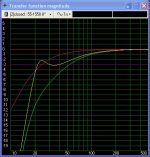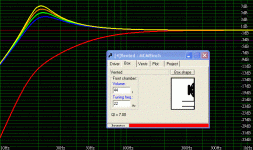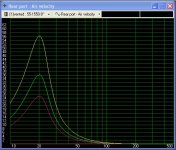I am starting a new thread to continue the discussion on a design of multiple 8" 45L subs. I am splitting this discussion off because the previous thread was branching into several topics.
The previous thread was:
http://www.diyaudio.com/forums/showthread.php?s=&threadid=29285&perpage=15&pagenumber=5
By high pass filter are you meaning a peak filter? with:
Q = 2.2
center frequency = 22
gain = 7 dB
On the 45L 22Hz tuned vented box this would produce the yellow line. The green line is the same vented box without the EQ. The pink line is the sealed box of the same volume.
Is this what you mean sreten?
The previous thread was:
http://www.diyaudio.com/forums/showthread.php?s=&threadid=29285&perpage=15&pagenumber=5
sreten said:
The EQ for the vented box is as I suggested is a Q of 2 to 3
22Hz second order high pass filter, if adjustable can be tuned
to the room, and due to room gain I advise adjustability.
For your -4dB at 20Hz only a boost of 7dB (Q=2.2) is required.
By high pass filter are you meaning a peak filter? with:
Q = 2.2
center frequency = 22
gain = 7 dB
On the 45L 22Hz tuned vented box this would produce the yellow line. The green line is the same vented box without the EQ. The pink line is the sealed box of the same volume.
Is this what you mean sreten?
Attachments
I must admit I haven't played with the ideal alignment.
Usually you take the reflex alignment, detune the port by root2
(in this case from 37 Hz to 26Hz) and apply mild boost with a
say 25Hz Q between 1 and 2. (if needed due to room gain)
I can see that the arbitary choice of 20Hz as the lower limit,
rather than something based on the driver parameters makes
tuning somewhat more difficult, if you want to avoid peaking.
In this case I'd suggest a combination of a (no order) step filter,
RCR, pre-equing some bass boost, and a second order say 20Hz
high pass adjustable between Q = 1 to 2, target Q =1.4 (+3dB).
This means the RCR step filter needs to add 4dB bass boost, its
probably best to design this with say 7dB and be - 3dB at 20Hz.
Note that the adjustability gives 5dB range but will sound like ~10dB.
 sreten.
sreten.
(graphic shows 20Hz, Q = 1.5, 1.75, 2, 2.25)
Usually you take the reflex alignment, detune the port by root2
(in this case from 37 Hz to 26Hz) and apply mild boost with a
say 25Hz Q between 1 and 2. (if needed due to room gain)
I can see that the arbitary choice of 20Hz as the lower limit,
rather than something based on the driver parameters makes
tuning somewhat more difficult, if you want to avoid peaking.
In this case I'd suggest a combination of a (no order) step filter,
RCR, pre-equing some bass boost, and a second order say 20Hz
high pass adjustable between Q = 1 to 2, target Q =1.4 (+3dB).
This means the RCR step filter needs to add 4dB bass boost, its
probably best to design this with say 7dB and be - 3dB at 20Hz.
Note that the adjustability gives 5dB range but will sound like ~10dB.
(graphic shows 20Hz, Q = 1.5, 1.75, 2, 2.25)
Attachments
I said:
I should have said that the pink line was an Linkwitz Transformed sealed sub with f of 20Hz and Q of .6
moving_electron said:I
On the 45L 22Hz tuned vented box this would produce the yellow line. The green line is the same vented box without the EQ. The pink line is the sealed box of the same volume.
I should have said that the pink line was an Linkwitz Transformed sealed sub with f of 20Hz and Q of .6
sreten said:
In this case I'd suggest a combination of a (no order) step filter,
RCR, pre-equing some bass boost, and a second order say 20Hz
high pass adjustable between Q = 1 to 2, target Q =1.4 (+3dB).
This means the RCR step filter needs to add 4dB bass boost, its
probably best to design this with say 7dB and be - 3dB at 20Hz.
Note that the adjustability gives 5dB range but will sound like ~10dB.
It looks like one of the challenges with boosting the low end is getting the port sized large enough to keep the port noise down.
I haven't tried the filter you describe in your last post yet but have modeled things with the +7dB peak filter.
A 2 inch diameter port is a pretty reasonable length of 9.5 in. But with the 20watt input it has a port air velocity of a whopping 56 ft/sec. If I reduce the input to get it down to the often recommended 17 ft/sec the output is about the same as the sealed.

A 3" port gets the velocity down to 24 ft/sec but the port is 22 inches long and takes up 10 liters of space.

2.5" port that is 15 inches long is probably the best solution for in the box, taking up about 5 liters. Any output past 5 watts though will start to raise the air velocity above 17 ft/sec.
In the graph below yellow is a 2" diameter port, green is 2.5" port and pink is a 3" port.
Attachments
Yes indeed, again your 20Hz limit is making things extremely difficult.
Lets put the whole thing in context and consider you are using
4 reflexed 8" bass drivers, so something similar to the Puppy.
The efficiency ball park is also similar to the Puppy,
if slightly higher at ~ 92dB/2.83V for a pair, but
note that the Wilson Puppy is tuned to 26Hz.
I always think of bass in terms equal tones below bottom
E on my bass which is 44Hz. An octave lower is obviously
22Hz, which I tend to regard as the absolute limit.
Note there are 6 tones per octave for an equal tone scale.
The 1/3 octave points are 35Hz and 28Hz, 1/6 39, 31, & 25 Hz.
So 25Hz only loses 1/6 of an octave which is basically one tone.
With 25Hz tuning max SPL over sealed is 12dB at 22Hz but
interestingly at 30Hz it goes from 7dB-20Hz to 10dB-25Hz.
Cutoff point is 22Hz, for -4dB, boost of 6dB is required.
single driver :
Power handling increases to 23W minimum, but more importantly
maximum SPL in the low bass goes from 94-96dB to 96-98dB.
Appropriate power per driver becomes 35W to 40W.
(Note 28Hz tuning gives 98-100dB, cutoff of 25Hz, 26W handling)
I'd suggest a port tuning of 25Hz would ease port length somewhat.
I'll also note you'll need one the advanced flared ports with adjustable
length, I can't model these but apparently they are quite effective,
and should ease the volume the port takes up.
Also note if the box internal volume is 44L this can be increased
by foam lining and stuffing away from the port by 10% to 15%.
 sreten.
sreten.
Lets put the whole thing in context and consider you are using
4 reflexed 8" bass drivers, so something similar to the Puppy.
The efficiency ball park is also similar to the Puppy,
if slightly higher at ~ 92dB/2.83V for a pair, but
note that the Wilson Puppy is tuned to 26Hz.
I always think of bass in terms equal tones below bottom
E on my bass which is 44Hz. An octave lower is obviously
22Hz, which I tend to regard as the absolute limit.
Note there are 6 tones per octave for an equal tone scale.
The 1/3 octave points are 35Hz and 28Hz, 1/6 39, 31, & 25 Hz.
So 25Hz only loses 1/6 of an octave which is basically one tone.
With 25Hz tuning max SPL over sealed is 12dB at 22Hz but
interestingly at 30Hz it goes from 7dB-20Hz to 10dB-25Hz.
Cutoff point is 22Hz, for -4dB, boost of 6dB is required.
single driver :
Power handling increases to 23W minimum, but more importantly
maximum SPL in the low bass goes from 94-96dB to 96-98dB.
Appropriate power per driver becomes 35W to 40W.
(Note 28Hz tuning gives 98-100dB, cutoff of 25Hz, 26W handling)
I'd suggest a port tuning of 25Hz would ease port length somewhat.
I'll also note you'll need one the advanced flared ports with adjustable
length, I can't model these but apparently they are quite effective,
and should ease the volume the port takes up.
Also note if the box internal volume is 44L this can be increased
by foam lining and stuffing away from the port by 10% to 15%.
The 3" port is looking better as an option. I miscalculated the volume it takes up. It is about 3 liters rather than 10, which makes it pretty workable. The 22.5 inch length could be accommodated by going straight back about 12 inches and then upwards for the rest. Using a 3 inch flared port and knowing that they will not be driven to max (if 4 subs are used) should mean there is no discernable port noise.
Things do get even easier if the goals are relaxed a bit as you point out. I agree it is unlikely that we would watch a movie and think "That would have been a good movie if there had been that one more lower frequency." .
.
Still it is interesting to see what can be done. I am actually pretty bullish on getting close to the original goal.
Some drivers arrived and I was able to get them installed in some completed sealed cabinets, bringing the total to 4. I fired them up and tried them out on some music that I am using as benchmarks. According to a RTA they have strong content in the high 20s range. For the test they were not dispersed around the room but were along the wall with the main speakers. So acoustic coupling was assured.
The results are very encouraging. The base was very solid and tight to my ear. Not to surprising since they are sealed and low Q.
I was able to push the volume up quite high, much higher than I would listen to except for a very short time. It was enough bass volume to be easily felt 2 floors up.
So I am pretty bullish on being able to reach some lower frequencies with sufficient volume with vented and/or a larger number.
The easiest way to try out the vented is to take one of the existing boxes and try some different vent tunings with some external piping.
Things do get even easier if the goals are relaxed a bit as you point out. I agree it is unlikely that we would watch a movie and think "That would have been a good movie if there had been that one more lower frequency."
Still it is interesting to see what can be done. I am actually pretty bullish on getting close to the original goal.
Some drivers arrived and I was able to get them installed in some completed sealed cabinets, bringing the total to 4. I fired them up and tried them out on some music that I am using as benchmarks. According to a RTA they have strong content in the high 20s range. For the test they were not dispersed around the room but were along the wall with the main speakers. So acoustic coupling was assured.
The results are very encouraging. The base was very solid and tight to my ear. Not to surprising since they are sealed and low Q.
I was able to push the volume up quite high, much higher than I would listen to except for a very short time. It was enough bass volume to be easily felt 2 floors up.
So I am pretty bullish on being able to reach some lower frequencies with sufficient volume with vented and/or a larger number.
The easiest way to try out the vented is to take one of the existing boxes and try some different vent tunings with some external piping.
sreten said:If I understand flared ports correctly something like a 2"
internal diameter = 3" plain pipe, and has the obvious
advantage of being much shorter than the 3" plain pipe.
sreten.
I note that on the flaired ports (flaired on both ends) the manufacturers claim up to 3dB more output before noise.
Taking this at face value this is a very nice benefit as I assume it means you can apply twice the power before hitting a audible threshold.
For my early experiments on the vented I will probably first be sticking some 3 inch pipe out the back of an existing sealed box using a pipe flange and some pipe. I should be able to put a flair on each each end to try it out.
Thanks for all the help and coaching.
- Status
- This old topic is closed. If you want to reopen this topic, contact a moderator using the "Report Post" button.
- Home
- Loudspeakers
- Multi-Way
- Continuation of 8" 45L sub with low end EQ


